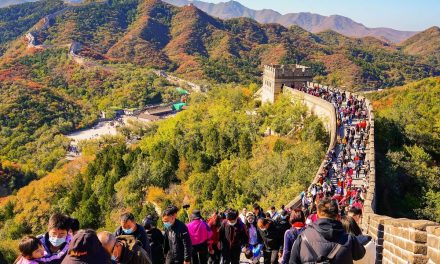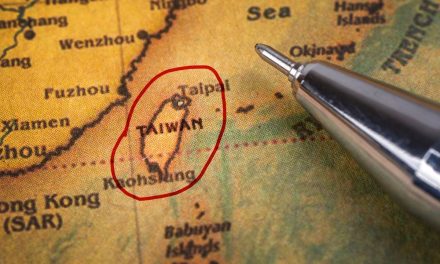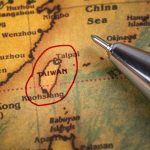Located in China’s southeast, Fujian province is one of the most culturally and linguistically diverse areas of the country.
And it’s mostly undiscovered by travelers from outside of China.
This makes it the ideal destination for intrepid travelers who want to get off the beaten path and see new things, places, and people.
To help you explore the province during your next foray into China, here’s an insider’s guide on the best things to do and see there (trust me – I’ve lived there!).
But first, here’s a little bit about this special province.
About Fujian province
Fujian is full of cities, nature areas, and historical and cultural sites.
It has a mild, subtropical climate that doesn’t get too cold in winter. This makes it a great travel destination, though in the summer months it does get quite humid.
Centuries ago, Fujian was one of ancient China’s trading centers for Persians and Arabs. This is why you’ll find a few mosques throughout the province.
The capital of Fujian province, Fuzhou, was China’s busiest tea port in the 19th century. Today, it still has amazing tea, as well as great shopping, delicious food, and lots of modern amenities.
Now, let’s take a look at seven of the best things to do in Fujian province.
1. Explore the provincial capital, Fuzhou
Depending on how you travel, the province’s capital is usually the first place that tourists visit when they arrive.
It’s convenient for travelers because it provides both international and domestic connections, and the city itself is an interesting mix of old and new, familiar and foreign.
Fuzhou doesn’t see a lot of overseas tourists, so you’ll probably get stared at as you wander around. Most people stick to Beijing and Shanghai, which is sad really as there’s so much more to China than the biggest cities.

Fuzhou is the capital of Fujian province. Image by Zarko Prusac on Shutterstock.
The local food in Fuzhou is intoxicatingly real and authentic, so make sure you take advantage of as many local restaurants as possible during your stay!
I would recommend taking between one and three days in Fuzhou to enjoy the local sites like:
- Sanfang Qixiang, an ancient labyrinth of streets and lanes that houses numerous historical buildings and sites as well as great places to eat
- West Lake Park, for relaxing and flowers in spring
- Drum Mountain Scenic Area for temples, nature, and hiking
- Pingtan Island for a beach experience and sea views.
If you plan on spending time here, check out my Fuzhou itinerary which will cover you for up to five days.
2. Soak up the beachy atmosphere of Xiamen
Fuzhou is often touted as a coastal city and yet it doesn’t have any beaches.
If you want to correct this oversight, then you need to travel to Xiamen. Located around three hours from Fuzhou by car, Xiamen offers all the coastal views and beach experiences you could dream about.
There are lots of things you should see and do in Xiamen. The world-famous Gulangyu Island is at the top of that list with its museums, gardens, and historic architecture.
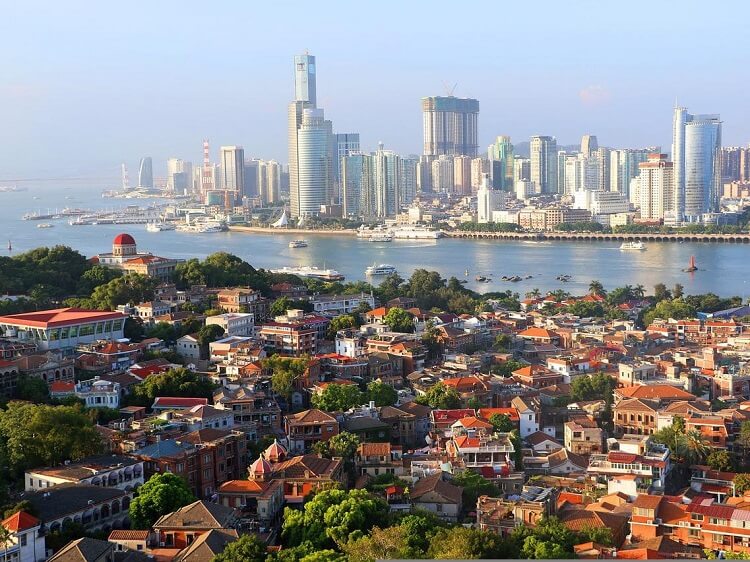
Gulangyu Island is a popular spot in Xiamen. Image by Image by chaoqianli_vip on Pixabay.
If you don’t see anything else in Xiamen, I really recommend taking a day to wander around this UNESCO World Cultural Heritage Site to see all the colonial architecture, eat at the local restaurants, and visit some of the museums. You really won’t regret spending a day on the island.
Other top attractions in Xiamen are:
- Nanputuo Temple, where you can enjoy great views of the city
- Zhongshan Road Pedestrian Street for snacks and shopping
- Xiamen University for a wander around the beautiful grounds.
I would recommend including at least two days in your Xiamen itinerary, just so you don’t have to rush around to see everything. Most people make Xiamen their base when they visit the province’s biggest drawcard, the Fujian Tulou, which I talk about further down.
There are plenty of great hotels in Xiamen so make sure you pamper yourself here.
3. Experience different cultures in Quanzhou
Located in the southeast of Fujian province, Quanzhou is around two hours south of Fuzhou and a 20-minute ride on the train from Xiamen.
Although the city is home to more than 8 million people, it rarely sees foreign tourists and still retains much of its authentic, traditional features.
In Quanzhou, you’ll see the most authentic traditional Fujian culture still in existence. The town has dark red houses and dovetail roofs that look like they’ve remained unchanged for the last 2,000 years.
Quanzhou is best known for its combination of cultures. You can find numerous world religions in the city from Christianity to Confucianism, Taoism, Islam, and Buddhism.
This mix of cultures is due to the fact that Quanzhou was once a prominent starting point of the Maritime Silk Road, and it makes Quanzhou a true pleasure to explore.
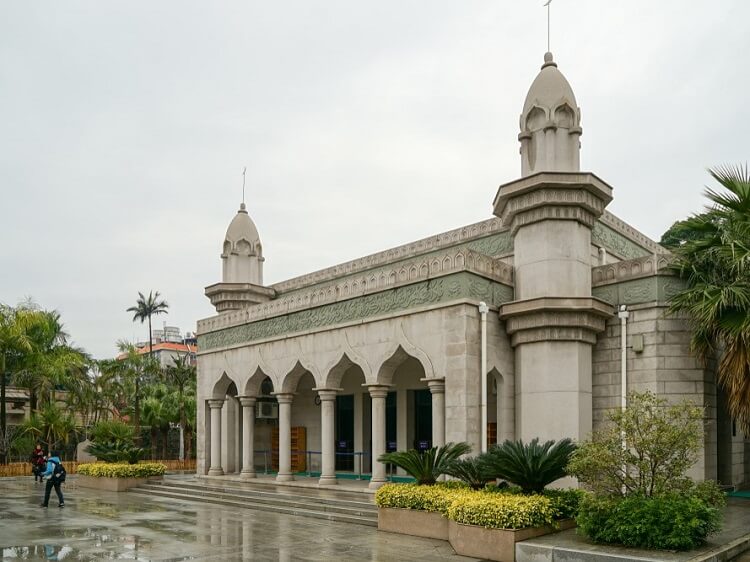
Qingjing, the oldest mosque in China. Image by Jiang Tianmu on Shutterstock.
Here are some amazing places to see and explore in Quanzhou:
- Guandi Temple, one of the most prosperous and active temples in the city
- Quanzhou West Street, the most complete ancient block in the city
- Confucian Temple
- Zhongshan Street, the best-preserved street of row-arcade buildings in the country
- Qingjing Mosque, the oldest, still surviving example of Islamic architecture in China
- Xunpu Village, for amazing seafood and colorful locals
- Luoyang Bridge, one of the four famous bridges of ancient China.
If you’re into Chinese culture, make sure you check out this guide to Chinese culture and traditions.
4. Marvel at the Fujian Tulou
Tulou are communal homes made by the Hakka people, who lived in mountainous areas of Fujian from the 11th century onwards.
The word ‘tulou’ literally translates as earthen building, and this description accurately describes the giant rectangular, circular, or square buildings with communal courtyard on the inside.
These buildings could house between 150 to 800 people. They look a bit like missile silos and were in fact mistaken for them during the Cold War.
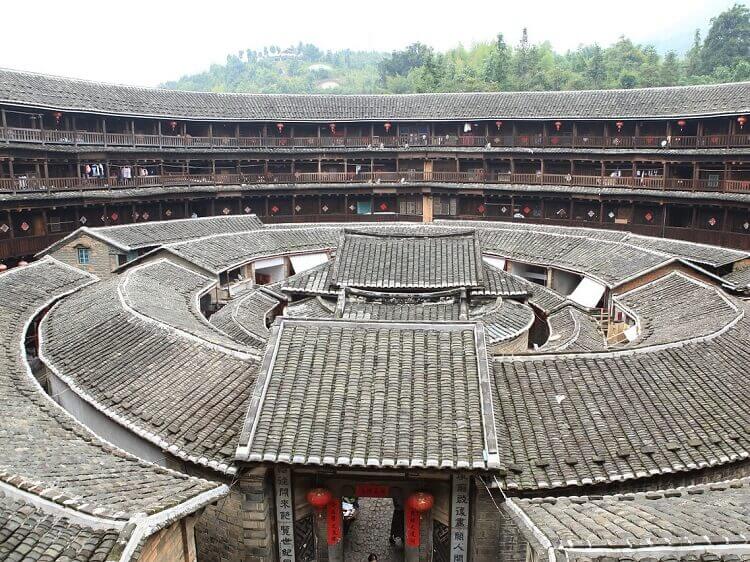
The province is most well-known for the Tulou buildings. Image by 庆锋张 on Pixabay.
There are thousands of these buildings in the most remote parts of Fujian and one of the best places to see them is in Nanjing County. This is where you’ll find a large cluster of Tulou buildings that are very popular among tourists.
They’re also just a short drive from Xiamen, making them convenient for a day or overnight trip from the city.
If you’re really pressed for time, then I recommend that you see the Tianluokeng Tulou Cluster (田螺坑土楼).
It’s the most popular of all the Nanjing Tulou and consists of five huge buildings that are nicknamed ‘Four Dishes and One Soup’ for their unique shapes.
The site is also lit up at night for a beautiful, slightly haunting view.
I recommend you stay overnight in the area, as there are numerous hotels and hostels in the area. For a really unique experience, why not stay at one of the Tulou-style buildings to get a really authentic experience?
5. Visit the spectacular Taining World Geological Park
This UNESCO World Heritage Site is located in Taining County in the northwest of Fujian Province.
As the name suggests, it’s an important geological site and a vital part of China’s Danxai Landscape, a famously scenic part of China’s mountainous area.
The park consists of the truly enormous Taining Scenic Tourist Area, with nine sections including the popular Dajin Lake Scenic Area and Big Golden Lake Scenic Area.
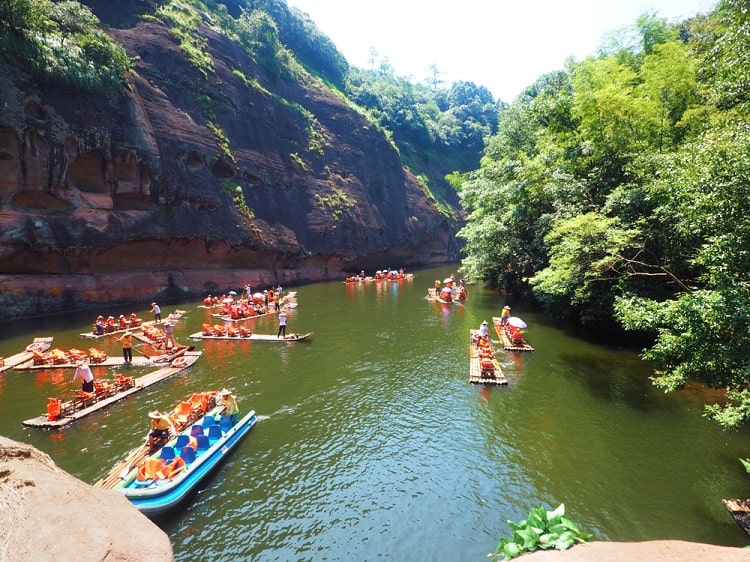
Rafting on the Shangqing. Image by Sunwand24 on Shutterstock.

Ganlu Temple is built into the cliff face. Image by Lucas Photo on Shutterstock.
The mountain views in this part of the park are matched only by the plunging crevasses and the Ganlu Temple, built on a terrifying looking cliff. The best way to explore this area is by boat so you can truly enjoy the enormous stone pillars rising against the wild landscape.
While you’re at Taining, you can also see sights like:
- Shangqing Stream, where you can enjoy bamboo rafting and Taoist fairytales
- Taining Old Town, with ancient buildings dating back over 500 years
- Nine Dragon Pond, where you can do some more boating along the winding springs
- Zhuangyuan Rock, once said to be where the high master Zhuangyuan of the Southern Song Dynasty studied
- Mao’er Hill National Forest Park, which is ideal for camping and trekking
- Eight Immortals Cliffs, which are almost 12 million years old and the oldest cliffs in southeast China.
You can get to Taining World Geological Park by bus from Xiamen, Fuzhou, or other cities in the province or by train.
My tip is to get on a private tour so you don’t miss the best bits.
6. Ride a bike on Meizhou Island
Meizhou Island is just over two hours’ drive from Fuzhou and is known as the Birthplace of the Chinese Goodness of the Sea, Mazu.
In the past, Mazu worship spread throughout the coastal provinces in China but the temple on Meizhou Island is the original, so it’s definitely worth seeing.
Aside from the history, Meizhou Island is a stunningly beautiful place, with beautiful coastal scenery that looks amazing in photos.
The area is replete with golden beaches, turquoise seas, and eroded rocks along the coast that look atmospheric and even romantic in the right light.
While you’re there, you’ll also get a chance to experience the sacred Mazu culture, which is a unique experience that shouldn’t be missed.
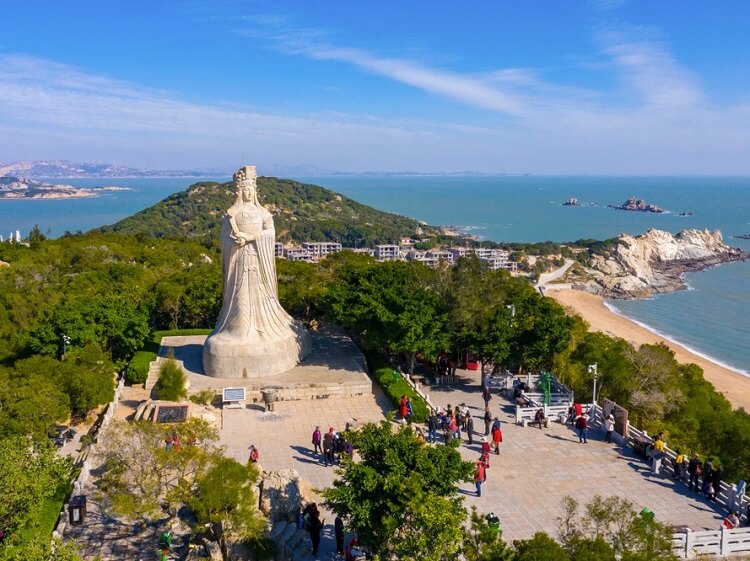
Mazu Statue on the island. Image by HelloRF Zcool on Shutterstock.
Here’s what to do on Meizhou Island:
- Eat some of the local seafood
- Rent a bike and ride around the island
- Visit the Matsu Temple
- Spend some time on Jiubaolan Golden Beach
- Explore the Mazu Cultural Park
- Go hiking and explore the scenery at Goose Tail Magic Stone Park.
To get to the island, you’ll need to take a ferry from Wenjia Wharf, which is about two hours from Fuzhou.
7. Climb up the Wuyi Mountains
The Wuyi Mountains are on the border of Fujian and Jiangxi provinces (you can explore all the Chinese provinces and regions here).
The whole area is a UNESCO World Heritage Site and the mountains are often described as some of the most beautiful in southeast China.
This is a place of dramatic gorges and beautiful water. It has amazing biodiversity and is home to a number of ancient, endangered animals that can only be found in China.
These mountains also contain numerous temples and monasteries, many in ruins, including the Han City from the 1st century BCE and temples that are associated with the birth of Neo-Confucianism in the 11th century CE.

Get stunning views at Wuyi Mountains. Image by Tshooter on Shutterstock.
If you love history and want to learn more about China’s history, then you’ll love this part of China.
While you’re in the Wuyi Mountains, I recommend taking a boat ride along the river so that you can enjoy the peaks soaring up on all sides. I also recommend visiting Nine-Bend Stream, where you can take in treacherous views from the ancient cliff tracks.
Just remember that the whole area is protected, so leave it as pristine as it was when you arrived.
You can get to the Wuyi Mountains by taking a tourist bus from Wuyishan City.
Best time to visit Fujian province
I’d say the best time to visit Fujian is during the shoulder seasons.
The shoulder seasons in China are between September and November to miss the coldest part of the year, and between March and May to miss the hottest.
But even if you travel outside of these seasons, you’ll find that the weather is fairly warm and humid year-round.
Heading to Fujian soon?
If you’re planning a trip to China, don’t forget the internet is censored.
So, when using Wi-Fi you won’t have access to your favorite sites and apps like Instagram, Facebook, WhatsApp, Gmail, Google and heaps more, unless you get a VPN before you go.
You can refer to this review for the best China VPN (or skip the review and go straight here).
Just make sure you download it before you arrive as the signup page will be blocked in China.
Off the beaten path in Fujian
When you travel in China, make sure that you see more than Shanghai and Beijing.
Get off the beaten path and meet people, see landmarks, and experience cultures that you wouldn’t expect and can’t find in the major cities.
With its long, interesting history and varied cultural heritage, Fujian Province is the perfect destination for any traveler who wants to go deeper in China.
When I lived there, I saw a side of China that the guidebooks never prepared me for.
And it’s this side of China, the food and the people and the color and the life, which I miss now that I’ve returned home.
Learn more about China
Main image credit: Mark1977 on Pixabay.
Frequently asked questions about Fujian
Where is Fujian province?
It’s a coastal province located in southeast China, north of Hong Kong and south of Shanghai. It’s across from Taiwan, by the Taiwan Strait.
How big is Fujian province?
The province is 121,400 sq km (46,900 sq mi) in size and home to over 40 million people.
What is Fujian province known for?
It’s famous for its mountains, coastal cities, and an incredible history and culture. The Fujian Tulou is the province’s biggest drawcard.
Where is Fujian province’s nearest airport?
There are airports in all the main cities including Xiamen, Fuzhou and Quanzhou.
How do you say ‘Fujian province’ in Chinese?
It’s Fújiàn shěng (福建省 in Chinese characters).


